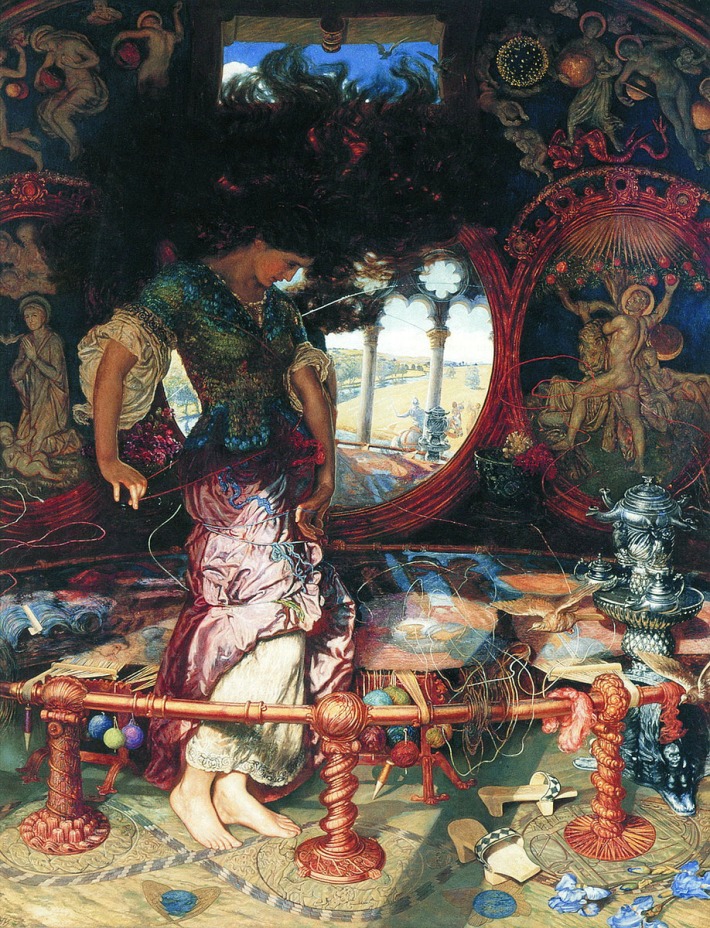[Re-posted from Floating Academy]
Last weekend I flew to DC to see the major exhibit, Pre-Raphaelities: Victorian Art and Design. DC is the only North American city where the exhibit is showing (having started in London, it next moves on to Moscow and Tokyo) so I felt really lucky to have family nearby, which made it easier to go.
I’d seen some of the paintings before at the Tate, and at the Holman Hunt exhibit a few years ago, which came to Toronto. But this exhibit was really marvelous in terms of the sheer number of paintings from many different galleries, some of which I may never have a chance to see again. Working in disability studies, I was especially happy to see Millais’s The Blind Girl (1856), which is at Birmingham.
The colours were luminous and lighter than I was expecting from reproductions I’d seen. Whenever I see Pre-Raphaelites in person, I’m always struck by the scale. Scale is one thing that tends to be flattened out in reproductions, but it was interesting to see on the one hand how tiny something like Rosa Brett’s The Mouse (1860) was tiny (see The Guardian review for a reproduction), while Holman Hunt’s The Lady of Shalott (1905) was enormous.
And now I’ve put an emormous thumbnail of the image into this post as well! I was also struck by the texture in many of the paintings–in The Lady of Shalott, the threads were raised such that they almost looked like Jackson Pollock whippets of paint surrounding the title figure.
I also always like taking a look at the frames when I see Pre-Raphaelite paintings, since they are usually original, often have the quotations that inspired the work (especially when the subject is Shakespearean or Tennysonian), and are ornate and interesting as of themselves. You never get to see the frames in reproductions, but they always strike me as an important part of how the paintings were originally conceived and exhibited.
There’s been a lively discussion on the VICTORIA-listserve about this exhibit over the last few days, with some wishing there had been more information and more of a linear biographical narrative, and others defending the thematic grouping of the pictures. I liked the thematic grouping around ideas like “nature” and “salvation”. (“Beauty” which was all paintings of women, aka Pre-Raphaelite “stunners” was a little bit more problematic for me.)
But I also wonder if part of the presumption is that we all know the biographical information behind the paintings, and have moved beyond it, or can dismiss it as juvenile gossip. If there hadn’t been a major chronological exhibit of the Pre-Raphaelites in 1984, could we move straight to the thematic and intellectual juxtapositions? I spent the months leading up to the exhibit reading the catalogue, which a kind friend gave me as a Christmas present, and indulging in a guilty pleasure, reading Franny Moyle’s Desperate Romantics. I have to admit it gave me a little thrill to see Holman Hunt’s The Awakening Conscience (1853), which I’d seen before without knowing any of the background, knowing that the model had paraded around it like a peacock the first time it was exhibited at the RA, which was highly inappropriate given the subject matter of a fallen woman realizing the error of her ways. Does this make me shallow? If so, I think I’m okay with a little shallowness in my appreciation of art.
On a more serious note, I think it’s easy for us to dimiss biographical narratives when we know them, but that it’s important to have this kind of information when it comes to things like knowing the material conditions that shape the making of a literary text or painting. That said, I think the thematic grouping was highly effective, especially in terms of highlighting the political and religious importance of the work, and in bringing in more works by women rather than relying on a master narrative of the development of a (male) artistic genius.
Finally, I will admit that I love looking at museum gift shops. At the end of this exhibit, I was fascinated to see all the needlework kits for things like William Morris pillows, showing that the kind of culture of crafting that Talia Schaffer describes in Novel Craft is alive and well. I refrained from buying one.
Overall, the exhibit was fantastic, and the main argument that the Pre-Raphaelites represent a kind of Victorian Avant-Garde was well-taken. Go see it if you can!
*All images courtesy Wikimedia Commons.


